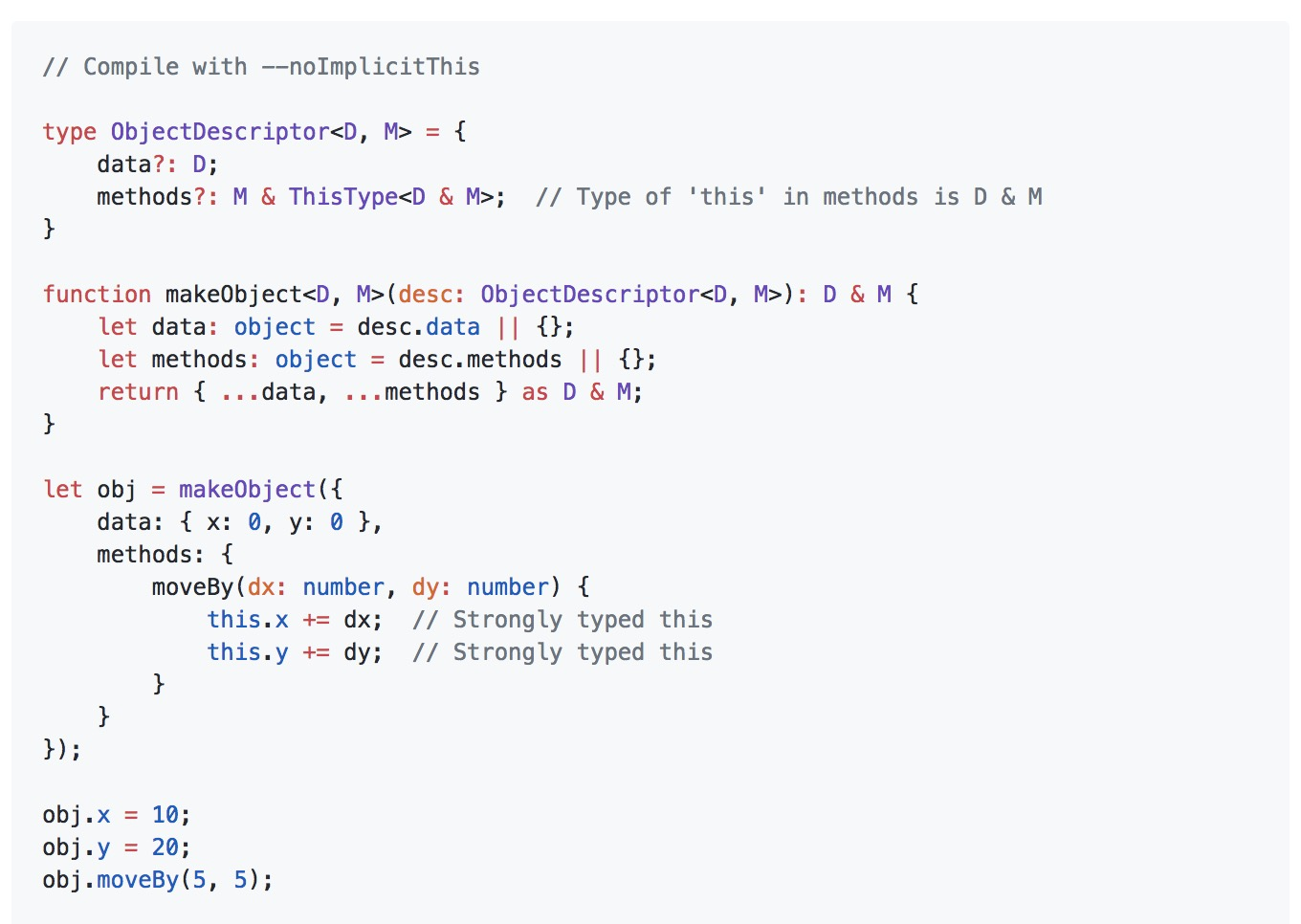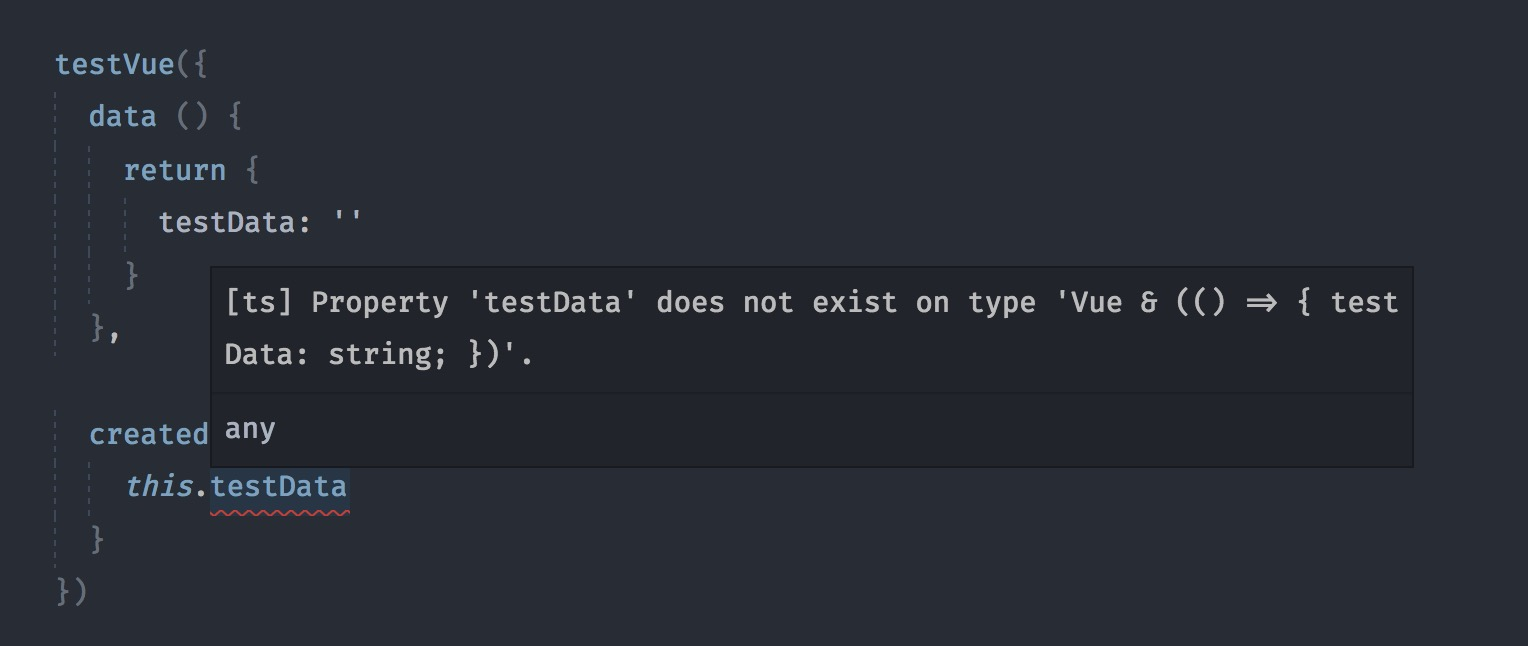在 2.5.0 版本中,Vue 大大改进了类型声明系统以更好地使用默认的基于对象的 API。
意味着当我们仅是安装 Vue 的声明文件时,一切也都将会按预期进行:
this,就是 Vue;this属性上,具有 Methods 选项上定义的同名函数属性;- 在实例 data、computed、prop 上定义的属性/方法,也都将会出现在
this属性上; - ......
在这篇文章里,我们来谈谈上述背后的故事。
Methods
当我们创建 Vue 实例,并在 Methods 上定义方法时, this 不仅具有 Vue 实例上属性,同时也具有与 Methods 选项上同名的函数属性:
new Vue({
methods: {
test () {
this.$el // Vue 实例上的属性
}
},
created () {
this.test() // methods 选项上同名的方法
this.$el // Vue 实例上的属性
}
})
为了探究其原理,我们把组件选项的声明改写成以下方式:
定义 Methods:
// methods 是 [key: string]: (this: Vue) => any 的集合
type Methods = Record<string, (this: Vue) => any>
这会存在一个问题,Methods 上定义的方法里的 this,全部都是 Vue 构造函数上的方法,而不能访问我们自定义的方法。
我们需要把 Vue 实例传进去:
type Methods<V> = Record<string, (this: V) => any>
组件选项(同样也需要传实例):
interface ComponentOption<V> {
methods: Methods<V>,
created?(this: V): void
}
我们可以使用它:
declare function testVue<V extends Vue>(option: ComponentOption<V>): V
此种情形下,我们必须将组件实例的类型显式传入,从而使其编译通过:
interface TestComponent extends Vue {
test (): void
}
testVue<TestComponent>({
methods: {
test () {}
},
created () {
this.test() // 编译通过
this.$el // 通过
}
})
这有点麻烦,为了使它能按我们预期的工作,我们定义了一个额外的 interface。
在 Vue 的声明文件里,使用了一种简单的方式:通过使用 ThisType<T> 映射类型,让 this 具有所需要的属性。
在 TypeScript 仓库 ThisType<T> 的 PR 下,有一个使用例子:

在这个例子中,通过对 methods 的值使用 ThisType<D & M>,从而 TypeScript 推导出 methods 对象中 this 即是: { x: number, y: number } & { moveBy(dx: number, dy: number ): void } 。
与此类似,我们可以让 this 具有 Methods 上定义的同名函数属性:
type DefaultMethods<V> = Record<string, (this: V) => any>
interface ComponentOption<
V,
Methods = DefaultMethods<V>
> {
methods: Methods,
created?(): void
}
declare function testVue<V extends Vue, Methods> (
option: ComponentOption<V, Methods> & ThisType<V & Methods>
): V & Methods
testVue({
methods: {
test () {}
},
created () {
this.test() // 编译通过
this.$el // 实例上的属性
}
})
在上面代码中,我们:
- 创建了一个 ComponentOption interface,它有两个参数,当前实例 Vue 与 默认值是
[key: string]: (this: V) => any的 Methods。 - 定义了一个函数 testVue,同时将范型 V, Methods 传递给 ComponentOption 与
ThisType。ThisType<V & Methods>标志着实例内的this即是 V 与 Methods 的交叉类型。 - 当 testVue 函数被调用时,TypeScript 推断出 Methods 为
{ test (): void },从而在实例内this即是:Vue & { test (): void };
Data
得益于上文中的 ThisType<T>,Data 的处理有点类似与 Methods,唯一不同之处 Data 可有两种不同类型,Object 或者 Function。它的类型写法如下:
type DefaultData<V> = object | ((this: V) => object)
同样,我们也把 ComponentOption 与 testVue 稍作修改
interface ComponentOption<
V,
Data = DefaultData<V>,
Methods = DefaultMethods<V>
> {
data: Data
methods?: Methods,
created?(): void
}
declare function testVue<V extends Vue, Data, Methods> (
option: ComponentOption<V, Data, Methods> & ThisType<V & Data & Methods>
): V & Data& Methods
当 Data 是 Object 时,它能正常工作:
testVue({
data: {
testData: ''
},
created () {
this.testData // 编译通过
}
})
当我们传入 Function 时,它并不能:

TypeScript 推断出 Data 是 (() => { testData: string }),这并不是期望的 { testData: string },我们需要对函数参数 options 的类型做少许修改,当 Data 传入为函数时,取函数返回值:
declare function testVue<V extends Vue, Data, Method>(
option: ComponentOption<V, Data | (() => Data), Method> & ThisType<V & Data & Method>
): V & Data & Method
这时候编译可以通过:
testVue({
data () {
return {
testData: ''
}
},
created () {
this.testData // 编译通过
}
})
Computed
Computed 的处理似乎有点棘手:它与 Methods 不同,当我们在 Methods 中定义了一个方法,this 也会含有相同名字的函数属性,而在 Computed 中定义具有返回值的方法时,我们期望 this 含有函数返回值的同名属性。
举个例子:
new Vue({
computed: {
testComputed () {
return ''
}
},
methods: {
testFunc () {}
},
created () {
this.testFunc() // testFunc 是一个函数
this.testComputed // testComputed 是 string,并不是一个返回值为 string 的函数
}
})
我们需要一个映射类型,把定义在 Computed 内具有返回值的函数,映射为 key 为函数名,值为函数返回值的新类型:
type Accessors<T> = {
[K in keyof T]: (() => T[K])
}
Accessors<T> 将会把类型 T,映射为具有相同属性名称,值为函数返回值的新类型,在类型推断时,此过程相反。
接着,我们补充上例:
// Computed 是一组 [key: string]: any 的集合
type DefaultComputed = Record<string, any>
interface ComponentOption<
V,
Data = DefaultData<V>,
Computed = DefaultComputed,
Methods = DefaultMethods<V>
> {
data?: Data,
computed?: Accessors<Computed>
methods?: Methods,
created?(): void
}
declare function testVue<V extends Vue, Data, Compted, Methods> (
option: ComponentOption<V, Data | (() => Data), Compted, Methods> & ThisType<V & Data & Compted & Methods>
): V & Data & Compted & Methods
testVue({
computed: {
testComputed () {
return ''
}
},
created () {
this.testComputed // string
}
})
当调用 testVue 时,我们传入一个属性为 testComputed () => '' 的 Computed,TypeScript 会尝试将类型映射至 Accessors<T>,从而推导出 Computed 即是 { testComputed: string }。
此外,Computed 具有另一个写法:get 与 set 形式,我们只需要把映射类型做相应补充即可:
interface ComputedOptions<T> {
get?(): T,
set?(value: T): void
}
type Accessors<T> = {
[K in keyof T]: (() => T[K]) | ComputedOptions<T[K]>
}
Prop
在上篇文章在 Vue 中使用 TypeScript 的一些思考(实践)中,我们已经讨论了 Prop 的推导,在此不再赘述。
最后
此篇文章是对 Vue typings 的一次简单解读,希望大家看得懂源码时,不要忘记了 Vue typings,毕竟 Vue typings 才是给程序行为以提示和约束的关键。
参考
- https://github.com/Microsoft/TypeScript/pull/14141
- http://www.typescriptlang.org/docs/handbook/release-notes/typescript-2-1.html#mapped-types
- https://github.com/vuejs/vue/blob/dev/types/options.d.ts